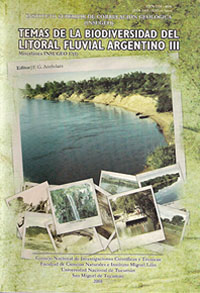Miscelánea 17 (1)
Distribución Histórica y Actual del Cardenal Amarillo (Gubernatrix cristata) en el Litoral Fluvial Argentino
Descargar trabajo en formato PDFResumen
DISTRIBUCION HISTORICA Y ACTUAL DEL CARDENAL AMARILLO (Gubernatrix cristata) EN EL LITORAL ARGENTINO. El cardenal amarillo (Gubernatrix cristata), se distribuye en Brasil, Paraguay, Uruguay y Argentina. En nuestro país históricamente tuvo una distribución muy amplia, pero en la actualidad las poblaciones más estables se encuentran en La Pampa, sur de Buenos Aires, norte de Río Negro, Corrientes y Entre Ríos. En el litoral argentino solo cuenta con poblaciones frecuentes en Corrientes y Entre Ríos, estas poblaciones son las mas estables genéticamente ya que no sufren el proceso de hibridación natural con la Diuca (Diuca diuca) que sufre en el sur de su distribución. La destrucción del Espinal y los intensivos trampeos para aves de jaula ha llevado a una gran disminución de las poblaciones naturales en gran parte de sus áreas de distribución. A pesar ser considerada una especie en peligro a nivel mundial y vulnerable a nivel nacional solo cuenta con dos áreas protegidas en el Litoral, y no posee programas activos para su conservación.
Abstract
HISTORICAL AND CURRENT DISTRIBUTION OF THE YELLOW CARDINAL (Gubernatrix cristata) IN THE ARGENTINEAN LITORAL. The Yellow Cardinal (Gubernatrix cristata) is distributed in Brazil, Paraguay, Uruguay and Argentina. In our country historically had a wider distribution, but at the present time the most stable populations are in La Pampa, Southern Buenos Aires, Northen Río Negro, Corrientes y Entre Ríos. In the Argentinean Litoral, there are only frequent populations in Corrientes and Entre Ríos. These populations are more stable genetically since don't suffer in the southern range of its distribution the process of natural hybridization with the Common Diuca Finch (Diuca diuca). The destruction of the Espinal one and the intensive trapps for cage birds have taken to a great decrease of the natural populations in a large part of their distribution areas. Although is considered a world wide endangered species, and vulnerable at national level it has only two areas protected in the Litotal, and it doesn't possess active programs for their conservation.






